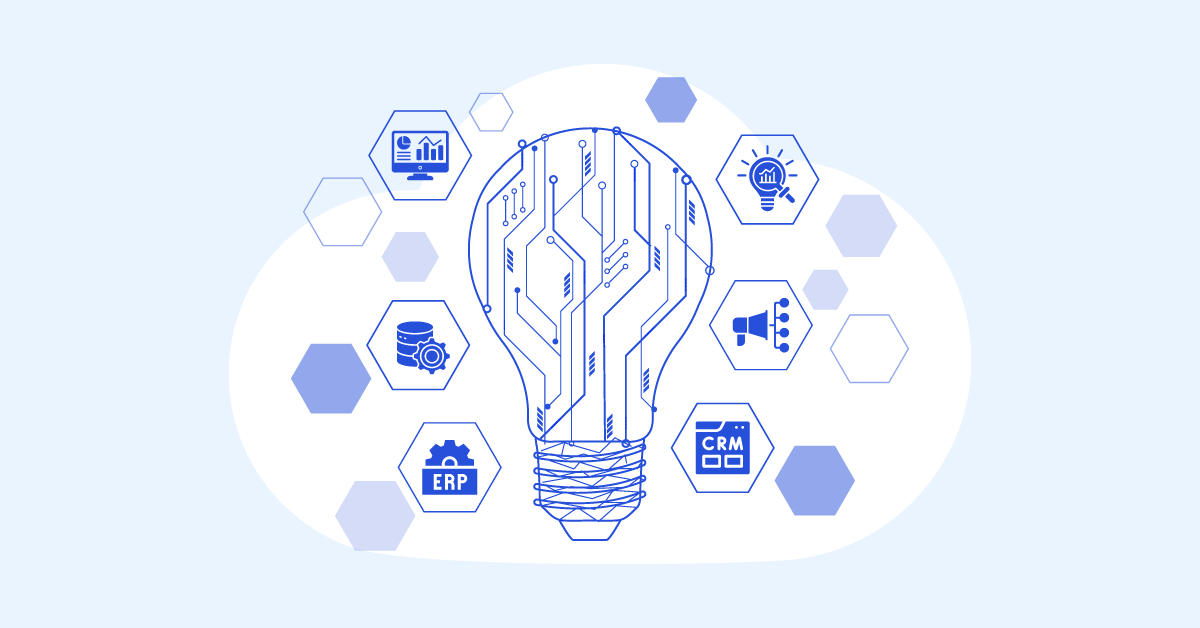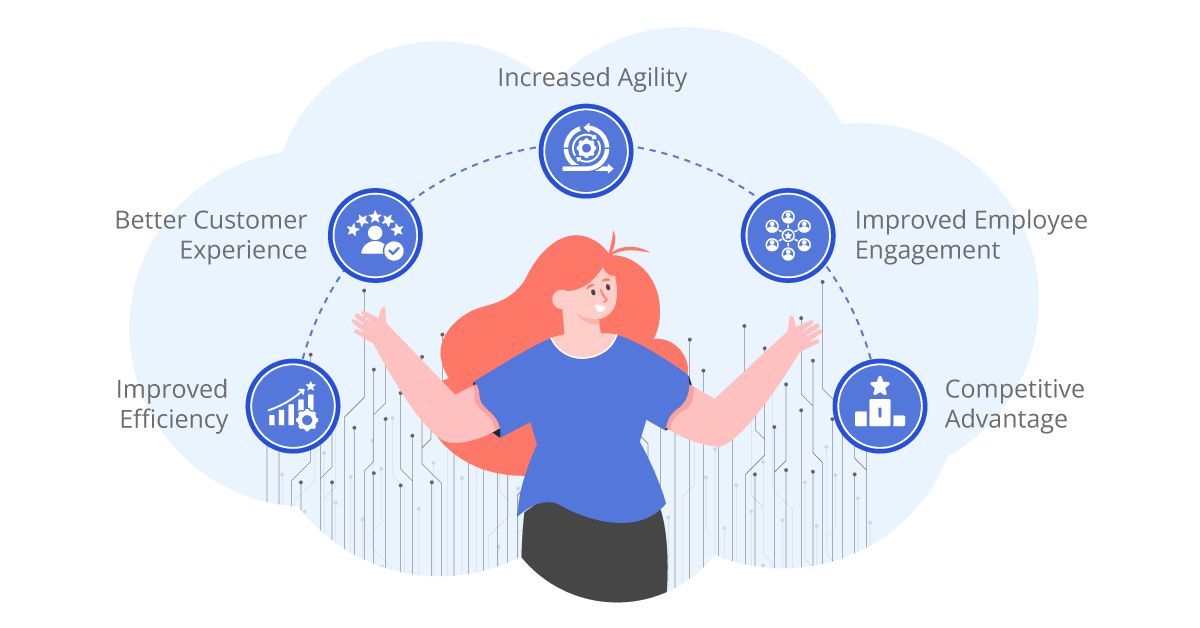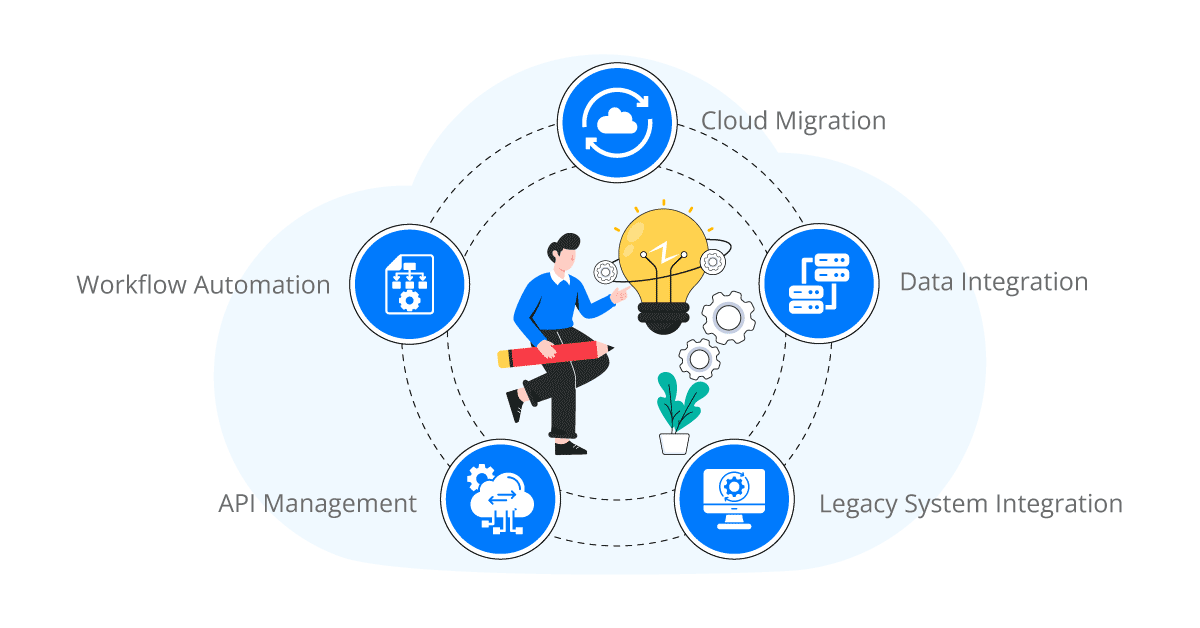Digital transformation has become a crucial aspect for businesses of all sizes in the current digital era. One of the main challenges for successful digital transformation is ensuring that the IT infrastructure is capable of handling the increased demand and new requirements. IPaaS (Integration Platform as a Service) is a useful tool to aid in the process of digital transformation by providing a quicker, simpler way of running processes through automation and integration.
This blog focuses on the positive impact of iPaaS on digital transformation.
Aonflow iPaaS – Free for First 3 Months!
Build and run up to 1,500 transactions monthly with no cost. No payment info needed!
Digital Transformation: What it is and how it works
Digital transformation refers to the integration of digital technology in all areas of a business or organization, resulting in fundamental changes to how they operate and deliver value to their customers. It involves the use of digital technology to streamline business processes, automate tasks, and provide better experiences for customers.
Digital transformation typically involves the adoption of new technologies such as cloud computing, artificial intelligence, and the Internet of Things (IoT). These technologies can help organizations improve their efficiency, reduce costs, and provide better customer experiences. However, digital transformation is not just about technology. It requires a fundamental shift in the way organizations think about and approach their business processes.
The process of digital transformation typically involves several steps. First, organizations need to assess their current technology infrastructure and identify areas where digital transformation can be most impactful. This often involves working with consultants or technology partners to identify the right technologies and strategies to achieve their goals.
Next, organizations need to develop a roadmap for implementing digital transformation. This involves setting clear goals and timelines for each stage of the transformation process. It also involves identifying the resources required, such as technology investments, staff training, and process changes.
Once the roadmap is in place, organizations need to begin implementing digital transformation. This often involves deploying new technology solutions, such as cloud-based applications, IoT devices, and AI-powered analytics tools. It also involves rethinking business processes and workflows to take advantage of new technologies.
Benefits of Digital Transformation
There are many benefits of digital transformation for businesses and organizations. Here are just a few:
Improved efficiency: Digital transformation can help organizations streamline their processes and automate repetitive tasks, resulting in improved efficiency and reduced costs.
Better customer experiences: Digital transformation can help organizations provide better experiences for their customers by leveraging data to personalize interactions and improve customer service.
Increased agility: Digital transformation can help organizations respond more quickly to changing market conditions and customer needs by enabling faster decision-making and more agile operations.
Competitive advantage: Digital transformation can help organizations gain a competitive advantage by enabling them to offer new products and services, enter new markets, and better serve their customers.
Improved employee engagement: Digital transformation can also help improve employee engagement by providing new tools and technologies that make it easier for employees to do their jobs and collaborate with others.
Digital transformation is no longer an option for businesses and organizations. It is a necessary step to remain competitive and meet the needs of customers in today’s digital age. While the process can be complex and challenging, the benefits of digital transformation are clear. By embracing digital technology and rethinking their business processes, organizations can improve their efficiency, provide better customer experiences, and gain a competitive advantage.
How does iPaaS enable Digital Transformation?
IPaaS offers an expedited and uncomplicated approach to accomplishing tasks and executing operations via automation and integration. This attribute is particularly valuable for businesses that use various technological systems across different departments and those seeking to elevate their IT Service Management processes. With the capacity to construct integrations swiftly, iPaaS can decrease integration development time by up to 90%, allowing businesses to allocate their resources and time elsewhere.
Using a codeless iPaaS integration and workflow platform helps to keep companies up-to-date with digital transformation by reducing integration backlogs. This leads to a more productive environment where team members can avoid going into multiple systems to change the same piece of data repeatedly. The increased productivity allows employees to focus more on customers, providing them with a better service experience.
Aonflow is the leading integration platform.
You can kick-start by integrating your first-ever workflow in just a matter of minutes.
How does iPaaS enable the modernization of Legacy Systems?
Despite the availability of better options, many businesses tend to cling to their legacy systems since they are familiar with them. This can be an obstacle to innovation and growth. However, with the integration of iPaaS, companies can have the best of both worlds, as it simplifies the integration of legacy systems. By doing so, businesses can access more advanced tools while still retaining their legacy systems. iPaaS provides a hybrid cloud environment that enables secure integration of both cloud and on-premise data. Additionally, iPaaS doesn’t always require the expertise of specialists to get started due to its codeless nature. Therefore, anyone can create an integration or workflow with ease.
Upgrading outdated legacy systems can have a significant impact on a company’s operations. By providing employees with advanced tools, organizations can improve cross-functional collaboration, communication, and transparency. Maureen Fleming, the Program VP of Intelligent Process Automation Research at IDC, has stated that companies will increasingly look to extend and re-platform their legacy integration software by leveraging solutions like iPaaS. This allows companies to gain flexibility, pursue innovation, avoid being locked into a specific technology, and standardize their software choices. The trend toward modernization is expected to be disruptive in the coming years.
Pairing ESM/ITSM Platforms with iPaaS
The use of iPaaS with ITSM and ESM platforms allows for a more streamlined and efficient system. By automating processes and workflows across all applications, businesses can ensure that tasks are completed quickly and accurately. This can lead to higher customer satisfaction and a more efficient workforce.
In addition to improving efficiency and customer satisfaction, pairing ITSM/ESM platforms with iPaaS can also lead to cost savings. By automating processes, businesses can reduce the amount of time and resources required to complete tasks. This can lead to lower labor costs and more efficient use of resources.
Use Cases of Digital Transformation using iPaaS
As mentioned earlier, iPaaS can be a crucial tool in digital transformation initiatives for businesses of all sizes. Here are some of the most common use cases of iPaaS in digital transformation:
Cloud migration: iPaaS can help businesses seamlessly migrate their applications and data to the cloud. This can help them take advantage of the flexibility, scalability, and cost savings that the cloud offers.
Legacy system integration: Many businesses still rely on legacy systems that are not compatible with modern applications and software. iPaaS can help integrate these systems with newer applications and technologies, ensuring that businesses can continue to use their legacy systems without hindering their digital transformation efforts.
Data integration: Digital transformation initiatives require data from various sources to be integrated into a single, unified platform. iPaaS can help businesses achieve this by seamlessly integrating data from various sources, such as cloud-based applications, on-premises databases, and third-party APIs.
Workflow automation: iPaaS can help automate business workflows, allowing businesses to streamline their processes and reduce manual labor. This can result in improved efficiency, increased productivity, and cost savings.
API management: APIs are a crucial part of digital transformation initiatives, enabling businesses to create new applications and services that are integrated with existing systems. iPaaS can help manage APIs by providing tools for API creation, testing, and documentation.
Benefits of iPaaS in Digital Transformation
The benefits of iPaaS in digital transformation initiatives are many. Here are some of the most significant benefits:
Less Complex: iPaaS can help businesses reduce the complexity of their IT systems by providing a unified platform for integration and automation. This can make it easier for businesses to manage their IT systems and processes, reducing the burden on IT staff.
More Agile: iPaaS can help businesses become more agile by allowing them to quickly and easily integrate new applications and technologies. This can help businesses respond to changing market conditions and customer needs more quickly.
More Savings: iPaaS can help businesses save money by reducing the need for manual labor and streamlining workflows. This can result in significant cost savings over time.
More Scalable: iPaaS can help businesses scale their IT systems and processes to meet growing demand. This can be especially important for businesses experiencing rapid growth or seasonal fluctuations in demand.
Improved data management: iPaaS can help businesses improve their data management by providing a unified platform for data integration and management. This can help businesses make better decisions based on accurate and timely data.
Other Benefits of iPaaS Solutions
In addition to facilitating digital transformation, iPaaS provides a variety of benefits to organizations’ operations. One such benefit is cost-effective integration, which is achieved through the use of a pre-built connector library that can be used for everyday systems, resulting in cost savings. With extensive use of APIs, organizations are exposed to security risks, while bespoke scripts are often uncontrolled and undocumented. A centralized integration platform, on the other hand, controls access points and workflows, resulting in improved security and compliance.
Another advantage of using iPaaS is the creation of a golden record. Organizations often struggle to achieve a single source of truth because data is stored in different systems. iPaaS makes it possible to harmonize and transform data to point to a true record. The use of a centralized connector library also leads to improved accuracy in workflows, making it easier for CIOs to connect and secure workflows across their various systems.
Process automation is a critical outcome of true digital transformation, and iPaaS helps improve employee efficiency in this area. Visual flow builders simplify the creation of workflows, enabling employees to do more in less time. These benefits are just a few examples of how iPaaS can help organizations improve their operations, reduce costs, and increase efficiency.
Conclusion
In today’s digital world, businesses must embrace digital transformation to remain competitive. iPaaS is a powerful tool that can help businesses achieve their digital transformation goals by providing a unified platform for integration and automation.
Whether you’re migrating to the cloud, integrating legacy systems with new applications, or automating workflows, iPaaS can help. By reducing complexity, improving agility, saving costs, and improving data management, iPaaS can help businesses achieve digital transformation success.
As with any technology, iPaaS requires careful planning and implementation to ensure success. Businesses must work with experienced iPaaS providers to ensure that their digital transformation initiatives are successful and provide the intended benefits.
Aonflow iPaaS – Free for First 3 Months!
Build and run up to 1,500 transactions monthly with no cost. No payment info needed!


